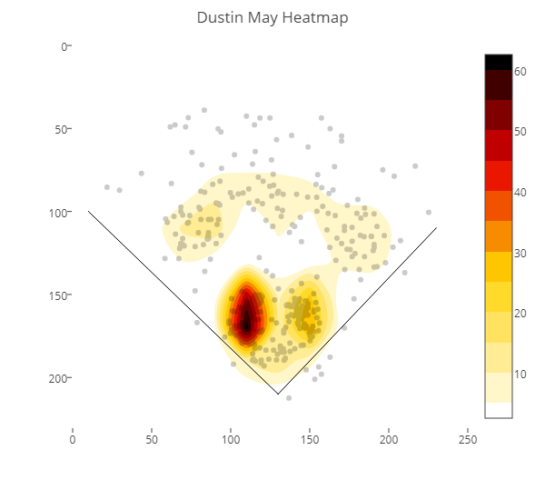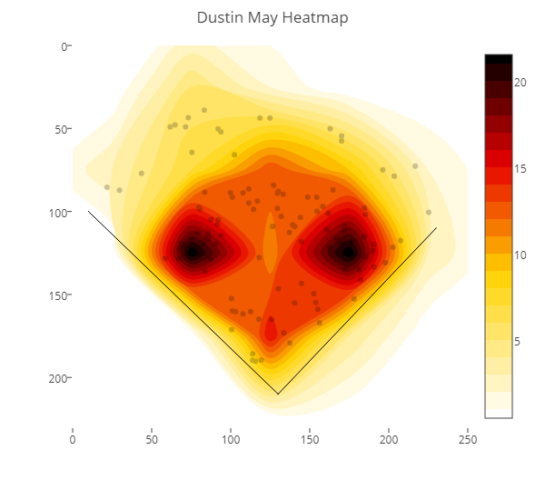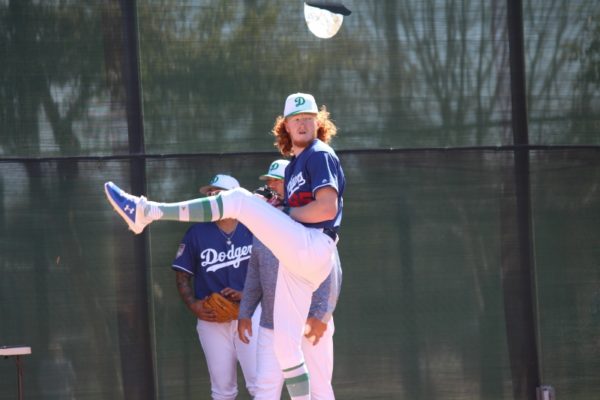Next up in the Top 100 countdown is the highest-ranked pitcher on the list. He took a big step forward last season that should get him to Los Angeles by next season.
——
Previously
- Introduction
- Past Underrated Prospects
- 100-51
- 50-41
- 40-31
- 30-21
- 20-11
- No. 10 – Estevez
- No. 9 – Downs
- No. 8 – White
- No. 7 – Santana
- No. 6 – Smith
- No. 5 – Gonsolin
- No. 4 – Lux
——
I’ve included Future Value (FV) grades and risks for the Top 50 prospects. For example, if a guy gets a “50 low,” he has a really good chance to be an average player at his position. If a guy gets a “55 high,” there’s a good chance he won’t reach that ceiling, but the potential is there. I tend to give higher future values because I take ceiling into account. The grades are 20-80 (50 is average), and the risks are as follows:
- Low: Players who are usually older, have debuted, are relievers and/or have higher floors than ceilings
- Medium: Players who are a mix of younger and older, usually have higher floors
- High: Players who are usually younger with potential, but also question marks
- Extreme: Players who are younger with star potential, but a ton of question marks
This is to show what value a player might provide at the MLB level. The higher the risk, the less likely a player will reach that ceiling.
——
Editor’s Note: I am not a scout (#notascout). I am an amateur when it comes to evaluating players. I don’t claim to be a pro, I just want to pass along the information I observe/obtain to the people. Notes and comments are based on personal observation, talking to sources, reading scouting reports and watching video. For future entries in this series: All ratings in the charts below are on the standard 20-80 scouting scale, where 50 is roughly average, 80 is elite and nearly unattainable and 20 is unacceptably poor. Enjoy.
Other notes: “Role” is a realistic future role (slightly optimistic in some cases). Age is the 2019 season age for the player (June 30 is the cutoff date).
——
Rating Key
| 80 – Elite |
| 70-75 – Plus-plus |
| 60-65 – Plus |
| 55 – Above-average |
| 50 – Average |
| 45 – Fringe-average |
| 40 – Below-average |
| 30-35 – Poor |
| 20-25 – Very Poor |
——
3. Dustin May
| DOB: 9/6/97 | Age: 21 | Height: 6’6 | Weight: 180 | Bats: Right | Throws: Right | Position: RHP |
| Tools | Now | Future |
| Fastball | 55 | 65 |
| Curveball | 55 | 65 |
| Changeup | 40 | 45 |
| Cutter | 50 | 60 |
| Cmd/Ctrl | 50 | 60 |
| Delivery | 50 | 55 |
| FV/Risk | 60 | High |
| Type of pitcher: Power, ground ball, improving swing-and-miss | ||
Acquired: 3rd round (No. 101 overall) of 2016 MLB Draft, Northwest HS (Texas), $1 million signing bonus
Physical description: Tall, skinny, lanky
Strengths: Premium fastball velo, swing-and-miss curve, hard cutter, great command/control
Weaknesses: Changeup lacking, long-term durability concerns because of frame, not as many whiffs as expected
Key statistics: 3.39 ERA, 3.80/3.22 FIP (A+/AA), 22.1 K%, 5.2 BB%
Summary: The Dodgers made May a 3rd-round pick in 2016, and I’m not sure they even saw this kind of ascendance. At age 20, he made it to Double-A and contributed to a Texas League championship for the Drillers (2.70 ERA in two starts). He didn’t allow a home run in 34 1/3 innings with Tulsa after giving up nine with Rancho Cucamonga in the hitter-friendly California League. He posted better than 50 percent ground ball rates, which should be a calling card of his going forward.
The ground balls are great, but what has folks really excited is the up-tick in his stuff. Before last season, he sat in the low-90s with his fastball and touched the mid-90s. In 2018, he saw his velocity sit at 93-96 and touch 98 MPH. What makes it even better is the incredible run and sink he generates. It produces a ton of ground balls and should continue as he moves up the ladder because he has such good command of the pitch — something that isn’t normally said about most pitchers with sinking fastballs. It should also generate some swinging strikes when he goes up in the strike zone with the 4-seam variety. Another big step he took in 2018 was separating his curveball and slider into separate pitches. His low-to-mid-80s curveball is his best offspeed offering. It’s a powerful, high-spinner with good depth and an 11-5 shape that generates a lot of swinging strikes. He ditched the slider in favor of a cut fastball, and that has paid off for him. It’s a low-90s pitch that gets in on lefties and helps neutralize them (.270 batting average against in ’17, .245 in ’18). Because of that, his fringe-average changeup (mid-80s) is less of a concern than it normally would be.
May has a surprisingly repeatable delivery because of his high leg kick, but he’s able to command his pitches because of his athleticism. He has a bit of an arm-whip as he releases his pitches from an almost three-quarters arm slot, but the quickness of his arm is why he’s able to generate high velocity on his fastball/sinker. The biggest concern with im going forward is if he’s going to be able to hold up over the course of a long season. He has thrown 134 (plus four in the postseason) and 132 2/3 innings (plus 10 in the postseason) in the last two years with almost no issues (10-day IL stint at the end of 2017). But he’ll be throwing higher-stress pitches in the majors, so we’ll see how he handles that.
If he’s able to either refine his changeup or improve his curveball and cutter even more, he has top-of-the-rotation potential. At worst, he’s a No. 3/4 starter. I’m gonna settle in the middle and slap a solid No. 2/3 future role on him. He began the season with Tulsa and could conceivably see Triple-A Oklahoma City in the second half of the season.
Heatmaps
These heatmaps are to show where the pitcher’s batted balls tend to fall (first map) and where his hits allowed go (second map).


Videos
2018 Ranking: 11
2019 Location: Double-A Tulsa/Triple-A Oklahoma City
ETA: 2020
Next Up: Prospect No. 2
 Dodgers Digest Los Angeles Dodgers Baseball Blog
Dodgers Digest Los Angeles Dodgers Baseball Blog
